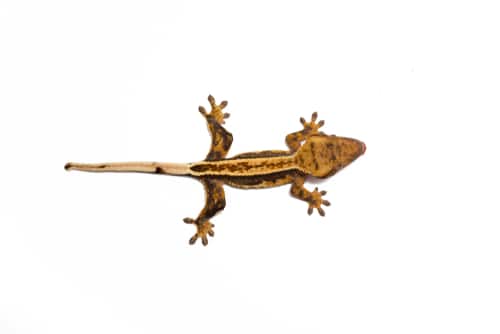Do Crested Geckos Need Heat? (Ideal Temperature Range)
Estimated reading time: 4 minutes
Even when you know nothing about crested geckos, you’ll probably know that they’re reptiles and that reptiles usually need a heat source to stay healthy. But not all reptiles need special heating equipment. So, do crested geckos need (extra) heat?
Crested geckos don’t need extra heat in moderate climates. A crested gecko is happiest at average (room) temperatures. The ideal temperature for a crested gecko during the day ranges from 72 to 78 °F (22 to 25 °C). The temperature can be lower at night, ranging between 69 and 74 °F (20 to 23 °C).
When you live in a region with a mild climate, you won’t need any heating equipment for your crested gecko. However, you may need to heat the enclosure during the winter or colder periods.
If you’re interested in stickers or other products of crested geckos, you can always visit our Etsy Shop, which is called Artful Animalia. We currently only send stickers in the United States. If you’re interested in certain crested gecko-related products, don’t hesitate to contact us.
In this article, you’ll learn why reptiles need heat to function properly and why crested geckos don’t need any heating but like average room temperatures. Next, you’ll learn what happens when a crested gecko is exposed to too much heat and cold. Finally, you’ll get some tips and tricks for creating a suitable temperature for your gecko.
This site contains affiliate links to products we recommend and use ourselves. We may receive a commission for purchases that you make through these links. If you’re interested in learning more about our affiliate links, please visit our (affiliate) disclaimer.
Why Do Reptiles Need Heat?
Reptiles are ectothermic or cold-blooded. They use the temperature of their surroundings to regulate their body temperature. When a reptile needs to raise its body temperature, it’ll find a warm spot. Likewise, they will seek a colder or shaded area when they need to cool down.
The temperature plays an essential part in many different processes of reptiles, such as their digestion and activity level. For example, you might have noticed that reptiles exposed to very low temperatures become inactive and don’t eat. Conversely, too high temperatures are also dangerous for reptiles as they might overheat and cause health issues.
Why Crested Geckos Don’t Need Heat?
Natural environment
The natural environment of crested geckos is found in the forests of New Caledonia. New Caledonia has two distinct seasons, one that is dry and cool and one that is wet and hot.
The dry season lasts from April to November. Temperatures during this season range from 17 to 27 °C. The wet season lasts from December to March. Temperatures during this season can rise to 32 °C. The combination of the high temperatures and the high amounts of rain in this season cause a humid environment which the crested geckos like.
Ideal temperature in captivity
The ideal temperature for crested geckos ranges from 72 to 78 degrees Fahrenheit (22 and 25 degrees Celsius) during the day. During the night, they can handle lower temperatures. At night the temperature should range between 69 and 74 degrees Fahrenheit (20 and 23 degrees Celsius).
So, crested geckos don’t need high temperatures. If you look at these temperatures, you will see roughly the same temperatures that humans like. Most room temperatures will be fine for a crested gecko. So if you live in a mild climate and the room temperature is between these temperatures, you should be fine.
What Happens When Crested Geckos are Exposed to Heat and Cold?
Exposure to hot temperatures
If you live in a hot region or if there’s a really hot summer, you’ll need to move the terrarium into a cooler room. Crested geckos can have stress from the heat and can even get a heat stroke if temperatures are above 85 degrees Fahrenheit (29 degrees Celsius).
Cresties can easily get overheated when it’s too hot. For example, when the terrarium is next to a window, the hot sun that shines through the window may raise the temperature in the terrarium fast. For that reason, I wouldn’t recommend placing the terrarium next to a window.
Exposure to cold temperatures
During the winter, cresties will tolerate night-time temperature drops as low as about 65 degrees Fahrenheit (18 degrees Celsius). They can even take temperatures as low as 50 degrees Fahrenheit (10 degrees Celsius) if they can warm up later.
However, if the temperature is consistently lower than 72 degrees Fahrenheit (22 degrees Celsius), you may need to provide additional heating. In most cases, a low-wattage incandescent bulb will provide enough warmth for your crestie and enough light for the live plants in the terrarium.
Want to Learn More?
If you want to learn more about crested geckos as pets, please read the following articles.
If you’re interested in getting crested geckos as pets you should also definitely read our article about baby and juvenile crested gecko care or (adult) crested gecko care.







